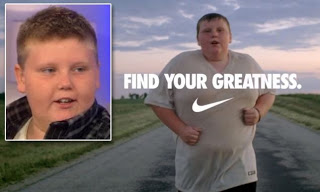 |
| Nathan Sorrel, 12 years old |
Yesterday I did a segment for Today. During the taping I was asked the inevitable “so what numbers are we talking about when it comes to weight in this country”. I mentioned that two thirds of adults were overweight or obese however I don’t focus on these figures. The statistics and obesity anxiety or weight terror- alert doesn’t help. So what does?
A study from the Rudd Center at Yale University concluded two things were helpful when it came to messaging about weight or eating. We tend to respond to messaging that’s supportive and information that encourages a specific behavior. The Let’s Move campaign is a great example of keeping it positive (and not preachy) and providing relevant resources.
How about advertisers? Yesterday’s segment focused on a front page USA Today article about the trend in casting overweight people in ads. While inclusivity is always good, I think we have to look at the motivation. Are the ads designed to sell products? To stir up controversy? Or to help foster change? Some of these ads have caused quite a ruckus.
Take this add from Blue Cross Blue Shield of Minnesota. An overweight mother and daughter are in the grocery store. The mother places unhealthy items in her cart and the daughter, with a mini cart, does the same. Let’s just say this didn’t sit well with many people including Lindy West on Jezebel (wish I had her with me for the napkin girls incident). I think Blue Cross could’ve made the same point saying “we’ve all been there and we don’t always set the best example for our kids.” Today you can change that and show a mother and child reading a label or making better market selections.
The Nike ad, that ran during the Olympics, was another example cited by USA today.
Nike shows an overweight boy jogging. The narration tells us greatness isn’t reserved for a select few, we are all capable of it. When I see it I smell a conference rooms of ad execs saying “we can’t sell shoes to a select few” it feels calculated. My kids had a different reaction. One of my boys said “it says never give up.” When the video finished the collage of other videos/ads displayed on the screen. My younger son said “the boy running in the commercial was big, none of those people are big.” He then said, “but in the world lots of people are big.” In his eight-year-old terms he could see this was unusual. However, regardless of its intensions it was supportive in its messaging and specific in its explicit message (to exercise). It also appeals to both overweight and non overweight…good for sales and health at the same time.
From years of counseling clients, a couple of things are clear. First, people know what to eat. They know what they “should” eat. Second, shame and guilt isn’t the answer. We all have an abundance of negativity swirling about in our heads when it comes to weight and food. To enact change, we have to go about things differently. We have to give people something they don’t already have.
What’s your reaction to more overweight people in ads? Do you think it’s inclusive or patronizing? And what about the parent’s? Should the parents let their children me the face of childhood obesity?

